Solar System
This article is about our solar system; for other planetary systems or stellar systems, see extrasolar planet.
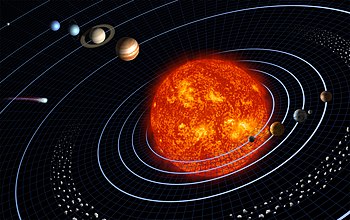
The solar system comprises the Sun and the retinue of celestial objects gravitationally bound to it: nine planets and their 165 known moons [1], as well as asteroids, meteoroids, planetoids, comets, and interplanetary dust. Astronomers are debating the classification of a potential tenth planet and other trans-Neptunian objects.
The principal component of the solar system is the Sun (astronomical symbol ☉); a main sequence G2 star that contains 99.86% of the system's known mass and dominates it gravitationally. [2]Because of its large mass, the Sun has an interior density high enough to sustain nuclear fusion, releasing enormous amounts of energy, most of which is radiated into space in the form of electromagnetic radiation, including visible light. The Sun's two largest orbiting bodies, Jupiter and Saturn, account for more than 90% of the system's remaining mass. (The currently hypothetical Oort cloud, should its existence be confirmed, would also hold a substantial percentage). [3]
In broad terms, the charted regions of the solar system consist of the Sun, four rocky bodies close to it called the terrestrial planets, an inner belt of rocky asteroids, four gas giant planets, and an outer belt of small, icy bodies known as the Kuiper belt. One planet, Pluto, is also a member of the Kuiper belt. In order of their distances from the Sun, the major planets are Mercury (☿), Venus (♀), Earth (♁), Mars (♂), Jupiter (♃), Saturn (♄), Uranus (♅/File:X - Uranus B.png), Neptune (♆), and Pluto (♇). All planets but two are in turn orbited by natural satellites (usually termed "moons" after Earth's Moon) and the largest are encircled by planetary rings of dust and other particles. The planets (with the exception of Earth) are named after gods and goddesses from Greco-Roman mythology.
For many years, the solar system had the only planetary system known. The discovery in recent years of many extrasolar planets has uncovered systems very different compared to Earth's solar system. Although the term "solar system" is frequently applied to these other star systems, literally, it should strictly refer to Earth's only: the word "solar" is derived from the Sun's Latin name, Sol. Other stellar systems or planetary systems are usually referred to by the names of their parent star; "the Alpha Centauri system" or "the 51 Pegasi system".
Layout and distances
Astronomers most often measure distances within the solar system in astronomical units, or AU. One AU is the average distance between the Earth and the Sun, or roughly 149 598 000 km. Other units in common use include the gigametre (abbreviated as "gm," one million kilometres) and the terametre ("tm", one billion/milliard kilometres). Pluto is roughly 38 AU (5.9 tm) from the Sun, while Jupiter lies at roughly 5.2 AU (778 gm).
Most objects in orbit round the Sun lie within the same shallow plane, called the ecliptic, which is roughly parallel to the Sun's equator. The major planets, with the exception of Pluto, lie very close to the ecliptic, while comets and kuiper belt objects often lie at significant angles to it. All of the major planets, and most other objects, also orbit in sync with the Sun's rotation.
All objects tied to the Sun have elliptical orbits. An ellipse is a circle stretched in one dimension, therefore a planet's distance from the Sun varies in the course of its year. Its closest approach to the Sun is known as its perihelion, while its farthest point from the Sun is called its aphelion. Though most major planets follow nearly circular orbits, with perihelions roughly equal to their aphelions, Pluto and the objects of the Kuiper belt follow highly elliptical orbits, with their perihelions and aphelions widely spaced apart.
There is a direct relationship between how far away a planet is from the Sun, and how quickly it orbits. Mercury, which is closest to the Sun, not only has the smallest orbital circumference but also travels the fastest, while Pluto, since it is much farther from the Sun, travels more slowly.
By and large, the planets within our solar system are arranged so that each is roughly double the distance from the Sun as the one before it. Venus is roughly twice as far from the Sun as Mercury, Earth is roughly double the distance as Venus, Mars double that of Earth, and so on. The exception is Neptune, which lies roughly halfway between Uranus and Pluto.
Sun

The Sun is the solar system's parent star, and far and away its chief component. It is classed as a moderately large yellow dwarf. However, this name is misleading, as on the scale of stars in our galaxy, the Sun is rather large and bright. The Sun is placed near the middle of the Hertzsprung-Russell diagram, but stars larger and hotter than it are rare, whereas stars dimmer and cooler than it are common. The vast majority of stars are red dwarfs, though their inherent dimness means they are under-represented in star catalogues, as we can observe only those few that are very near the Sun in space.
The Sun lies on the main sequence of the H-R diagram, which means, according to current theories of stellar evolution, that it is in the "prime of life" for a star, in that it has not yet exhausted its store of hydrogen for nuclear fusion, and been forced, as older red giants must, to fuse more inefficient elements such as helium and carbon. The Sun is growing increasingly bright as it ages. Early in its history, it was roughly 75 percent as bright as it is today. [4]Calculations of the ratios of hydrogen and helium within the Sun suggest it is roughly halfway though its life cycle, and will eventually begin moving off the main sequence, becoming larger, brighter and redder, until, about five billion years from now, it too will become a red giant.
The Sun is a population I star, meaning that it is fairly new in galactic terms, having been born in the later stages of the universe's evolution. As such, it contains far more elements heavier than hydrogen and helium ("metals" in astronomical parlance) than older population II stars such as those found in globular clusters. Since elements heavier than hydrogen and helium were formed in the cores of ancient and exploding stars, the first generation of stars had to die before the universe could be enriched with them. For this reason, the very oldest stars contain very little "metal", while stars born later have more. This high "metallicity" is thought to have been crucial in the Sun's developing a planetary system, because planets form from accretion of metals. [5]
The Sun radiates a continuous stream of charged particles, a plasma known as solar wind, ejecting it outwards at speeds greater than 2 million kilomtetres per hour, creating a very tenuous "atmosphere" (the heliosphere), that permeates the solar system for at least 100 AU. This environment is known as the interplanetary medium. Small quantities of cosmic dust (some of it arguably interstellar in origin) are also present in the interplanetary medium and are responsible for the phenomenon of zodiacal light. The influence of the Sun's rotating magnetic field on the interplanetary medium creates the largest structure in the solar system, the heliospheric current sheet. [6]
Earth's magnetic field protects its atmosphere from interacting with the solar wind. However, Venus and Mars do not have magnetic fields, and the solar wind causes their atmospheres to gradually bleed away into space.
Inner planets
The four inner or terrestrial planets are characterised by their dense, rocky composition and few or no moons or ring systems. They are composed largely of minerals with high melting points such as silicates to form the planets' solid crusts and semi-liquid mantles, and metallic dust grains such as iron, which forms their cores. Three of the four inner planets have atmospheres. All have impact craters, and all but one possess tectonic surface features, such as rift valleys and volcanoes. The term inner planet should not be confused with inferior planet, which designates those planets which are closer to the Sun than the Earth is (i.e. Mercury and Venus).
The four inner planets are:
Mercury

Mercury (0.4 AU), the closest planet to the Sun, is also the least massive of the inner planets, at only 0.055 Earth masses. It has no atmosphere, no natural satellite, and, to date, no observed geological activity save that produced by impacts. Its relatively large iron core and thin mantle have not yet been adequately explained. Hypotheses include that its outer layers were stripped off by a giant impact, and that it was prevented from fully accreting by the Sun's gravity. The upcoming MESSENGER probe should aid in resolving this issue.
Venus
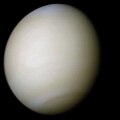
Venus (0.7 AU), the first truly terrestrial planet, is of comparable mass to the Earth (0.815 Earth masses), and, like Earth, possesses a thick silicate mantle around an iron core, as well as a substantial atmosphere and evidence of one-time internal geological activity, such as volcanoes. However, It is much drier than Earth and its atmosphere is 90 times as dense and is composed overwhelmingly of carbon dioxide and sulfuric acid. Unlike Earth, evidence suggests that Venus's crust is not divided into tectonic plates but instead comprises a single very thick rind. Distribution of impact craters suggests that Venus's surface features are all of the same relatively young age, suggesting that they are periodically erased by sudden, massive volcanism. However, recent computer remodelling suggests the resurfacing could have been as gradual as 2 billion years. [7] Venus has no natural satellite. It is the hottest planet with temperatures reaching 800+ degrees Celsius.
Earth and Moon

The largest and densest of the inner planets, Earth (1 AU) is also the only one to demonstrate unequivocal evidence of current geological activity. Its liquid hydrosphere, unique among the terrestrials, is probably the reason Earth is also the only planet where multi-plate tectonics has been observed, because water acts as a lubricant for subduction. [8] Its atmosphere is radically different from the other terrestrials, having been altered by the presence of life to contain 21 percent free oxygen. Its satellite, the Moon, is sometimes considered a terrestrial planet in a co-orbit with its partner, because its orbit around the Sun never actually loops back on itself when observed from above. [9] The Moon possesses many features in common with other terrestrial planets, though it lacks an iron core. The current generally accepted theory of the Moon's formation is that a large protoplanet, Theia, collided with the early Earth, merging its heavy core with the Earth's and sending a cloud of granitic crust into orbit, which refomed into the Moon. [10]
Mars
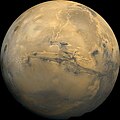
Mars (1.5 AU), at only 0.107 Earth masses, is less massive than either Earth or Venus. It possesses a tenuous atmosphere of carbon dioxide. Its surface, peppered with vast volcanoes and rift valleys such as Valles Marineris, shows that it was once geologically active and recent evidence[11] suggests this may have been true until very recently. Mars possesses two tiny moons (Deimos and Phobos) thought to be captured asteroids.
Asteroids
Asteroids are objects smaller than planets that are composed in significant part of rocky, non-volatile minerals.
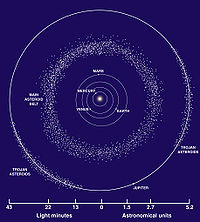
The main asteroid belt occupies the orbit between Mars and Jupiter, between 2.3 and 3.3 AU from the Sun. It is thought to be the remnants of a small terrestrial planet that failed to coalesce due to the gravitational interference of Jupiter. It contains tens of thousands (possibly millions) of asteroids over 1 km across,[12] though they can be as small as dust. Despite their large numbers, the total mass of the main asteroid belt is unlikely to be more than a thousandth of that of the Earth.[13] In contrast to its various depictions in science fiction, the main belt is very sparsely populated; several probes have passed through it without incident. Asteroids with a diameter of less than 50 m are called meteoroids. The largest asteroid, Ceres, has a diameter of almost 1000 km; large enough to be spherical, which would make it a planet by some definitions of the word.
Asteroids in the main belt are subdivided into asteroid groups and families based on their specific orbital characteristics. Asteroid moons are asteroids that orbit larger asteroids. They are not as clearly distinguished as planetary moons, sometimes being almost as large as their partners. The asteroid belt also contains main-belt comets[14] which may have been the source of Earth's water.
Trojan asteroids are located in either of Jupiter's L4 or L5 points, though the term is also sometimes used for asteroids in any other planetary Lagrange point as well.
The inner solar system is also dusted with rogue asteroids, many of which cross the orbits of the inner planets.
Outer planets
The four outer planets, or gas giants, (sometimes called Jovian planets) are so large they collectively make up 99 percent of the mass known to orbit the Sun. Jupiter and Saturn are true giants, at 318 and 95 Earth masses, respectively, and composed largely of hydrogen and helium. Uranus and Neptune are both substantially smaller, being only 14 and 17 Earth masses, respectively. Their atmospheres contain a smaller percentage of hydrogen and helium, and a higher percentage of “ices”, such as water, ammonia and methane. For this reason some astronomers suggested that they belong in their own category, “Uranian planets,” or “ice giants.” The term outer planet should not be confused with superior planet, which designates those planets which lie outside Earth's orbit (thus consisting of the outer planets plus Mars).
Jupiter
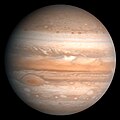
Jupiter (5.2 AU), at 318 Earth masses, is 2.5 times the mass of all the other planets put together. Its composition of largely hydrogen and helium is not very different from that of the Sun. Jupiter's strong internal heat creates a number of semi-permanent features in its atmosphere, such as cloud bands and the Great Red Spot. Three of its 63 satellites, Ganymede, Io and Europa, share elements in common with the terrestrial planets, such as volcanism and internal heating. Ganymede has a larger diameter than either Mercury or Pluto. Jupiter has a faint, smoky ring. Jupiter's intense gravitational pull attracts many comets, and may have played a role in lowering the number of impacts Earth has experienced in its history.[15]
Saturn
Saturn (9.5 AU), famous for its extensive ring system, has many qualities in common with Jupiter, including its atmospheric composition, though it is far less massive, being only 95 Earth masses. Two of its 49 moons, Titan and Enceladus, show signs of geological activity, though they are largely made of ice. Titan, like Ganymede, is larger than both Pluto and Mercury; it is also the only satellite in the solar system with a substantial atmosphere.
Uranus
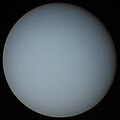
Uranus (19.6 AU) at 14 Earth masses, is the lightest of the outer planets. Uniquely among the planets, it orbits the Sun on its side; its axial tilt lies at over ninety degrees to the ecliptic. Its core is remarkably cold (compared to the other gas giants; it is still several thousand degrees) and radiates very little heat into space. This has led some to speculate that, unlike the similar Neptune, Uranus has no core. The weak heat means that Uranus's surface features are relatively bland, with little in the way of cloud bands. Some speculate that, should Uranus travel further from the Sun, the greater temperature difference between its outer layers and its internal heat might allow the creation of surface bands and storms. Uranus has 27 moons, five of which are relatively large, though none show any evidence of geological activity. Its ring system is dark and insubstantial, and composed of sparse fragments larger than 50 m in diameter.
Neptune

Neptune (30 AU), though slightly smaller than Uranus, is slightly more massive, at 17 Earth masses, and radiates more internal heat than Uranus, but not as much as Jupiter or Saturn. Its peculiar ring system is composed of a number of dense "arcs" of material separated by gaps. Neptune's largest moon, Triton, is geologically active, with geysers of liquid nitrogen. The heat at Neptune's core drives some of the fastest winds in the solar system. Neptune possesses marked surface features and cloud bands, though they appear far more changeable than those of Jupiter. The temperature of Neptune's upper atmosphere is similar to Uranus's.
Comets

Comets are small bodies (usually only a few kilometres across) composed largely of volatile ices, which possess highly eccentric orbits, generally having a perihelion within the orbit of the inner planets and an aphelion far beyond Pluto. When a comet approaches the Sun, its icy surface begins to sublimate, or boil away, creating a coma; a long tail of gas and dust which is often visible with the naked eye.
There are two basic types of comet: short-period comets, with orbits less than 200 years, and long-period comets, with orbits lasting thousands of years. Short-period comets are believed to originate in the Kuiper belt, while long period comets, such as Hale-Bopp (pictured), are believed to originate in the Oort Cloud. Some comets with hyperbolic orbits may originate outside the solar system. Old comets that have had most of their volatiles driven out by solar warming are often categorized as asteroids.
Centaurs are icy comet-like bodies that have less-eccentric orbits so that they remain in the region between Jupiter and Neptune. The first centaur to be discovered, 2060 Chiron, has been called a comet since it has been shown to develop a coma just as comets do when they approach the sun.[16]
Kuiper belt

The area beyond Neptune, often referred to as the outer solar system or simply the "trans-Neptunian region", is still largely unexplored.
This region's first formation, which actually begins inside the orbit of Neptune, is the Kuiper belt, a great ring of debris, similar to the asteroid belt but composed mainly of ice and far greater in extent, which lies between 30 and 50 AU from the Sun. This region is thought to be the place of origin for short-period comets, such as Halley's comet. Though there are estimated to be over 100,000 Kuiper belt objects with a diameter greater than 50 km, the total mass of the Kuiper belt is relatively low, perhaps barely equalling the mass of the Earth. [17] Many Kuiper belt objects have multiple satellites and most have orbits that take them outside the plane of the ecliptic.
Pluto and Charon
Astronomers consider Pluto, (38 AU average) the solar system's smallest planet, to be part of the Kuiper Belt population. Like other objects in the Kuiper belt, Pluto has a relatively eccentric orbit inclined 17 degrees to the ecliptic plane and ranging from 29.7 AU from the Sun at perihelion (within the orbit of Neptune) to 49.5 AU at aphelion.Pluto has a large moon (the largest in the solar system relative to its own size), called Charon, as well as two much smaller moons called Nix and Hydra. Like the Earth/Moon, Pluto and Charon are often considered a double planet, since both orbit a common barycenter between the two bodies.
Kuiper belt objects which, like Pluto, possess a 3:2 orbital resonance with Neptune (ie, they orbit twice for every three Neptunian orbits) are called Plutinos. Other Kuiper belt objects have different resonant orbits (2:1, 4:7, 3:5 etc) and are grouped accordingly. The remaining Kuiper belt objects, in more "classical" orbits, are classified as Cubewanos.

Scattered disc
Overlapping the Kuiper belt but extending much further outwards is the scattered disc. Scattered disc objects are believed to have been originally native to the Kuiper belt, but were ejected into erratic orbits in the outer fringes by the gravitational influence of Neptune's migration (see Formation of the solar system). Most scattered disc objects have perihelia within the Kuiper belt but aphelia as far as 150 AU from the Sun. Their orbits are also highly inclined to the ecliptic plane, and are often almost perpendicular to it. Some astronomers, such as David Jewitt, consider the scattered disc to be merely another region of the Kuiper belt, and describe scattered disc objects as "scattered Kuiper belt objects."[18]
2003 UB313 ("Xena")
One particular scattered disc object has renewed the old debate about what constitutes a planet since it is at least 5% larger than Pluto with an estimated diameter of 2400 km (1500 mi). It currently has no name, but has been given the provisional designation 2003 UB313, and has been nicknamed "Xena" by its discoverers, after the television character. [19]
The object has many similarities with Pluto: its orbit is highly eccentric, with a perihelion of 38.2 AU (roughly Pluto's distance from the Sun) and an aphelion of 97.6 AU, and is steeply inclined to the ecliptic plane, at 44 degrees, more so than any known object in the solar system except the newly-discovered object 2004 XR190, also known as "Buffy". [20] Like Pluto, it is believed to consist largely of rock and ice, and has a moon [21]
Farthest regions
The point at which the solar system ends and interstellar space begins is not precisely defined, since its outer boundaries are delineated by two separate forces: the solar wind and the Sun's gravity. The solar wind extends to a point roughly 130 AU from the Sun, whereupon it surrenders to the surrounding envionment of the interstellar medium. It is generally accepted, however, that the Sun's gravity holds sway to the Oort cloud. This great mass of up to a trillion icy objects, currently hypothetical, is believed to be the source for all long-period comets and to surround the solar system like a shell from 50,000 to 100,000 AU beyond the Sun, or almost a quarter the distance to the next star system. The vast majority of the solar system, therefore, is completely unknown; however, recent observations of both our solar system and others have led to an increased understanding of what is or may be lying at its outer edge.[22]
Sedna
Sedna is a large, reddish Pluto-like object with a gigantic, highly elliptical 10,500-year orbit that takes it from about 76 AU at perihelion to 928 AU at aphelion. Mike Brown, who discovered the object in 2003, asserts that it cannot be part of the scattered disc or the Kuiper Belt as it has too distant a perihelion to have been affected by Neptune's migration. He and other astronomers consider it to be the first in an entirely new population, one which also may include the object 2000 CR105, which has a perihelion of 45 AU, an aphelion of 415 AU, and an orbital period of 3420 years.[23]
Heliopause

The heliosphere expands outward in a great bubble to about 95 AU, or three times the orbit of Pluto. The edge of this bubble is known as the termination shock; the point at which the solar wind collides with the opposing winds of the interstellar medium. Here the wind slows, condenses and becomes more turbulent, forming a great oval structure known as the heliosheath that looks and behaves very much like a comet's tail; extending outward for a further 40 AU at its stellar-windward side, but tailing many times that distance in the opposite direction. The outer boundary of the sheath, the heliopause, is the point at which the solar wind finally terminates, and one enters the environment of interstellar space. [24] Beyond the heliopause, at around 230 AU, lies the bow shock, a plasma "wake" left by the Sun as it travels through the Milky Way. [25]
Galactic context


The solar system is located in the Milky Way galaxy, a barred spiral galaxy with a diameter estimated at about 100,000 light years containing approximately 200 billion stars. The galaxy is a spiral, and our Sun resides in one of the outer spiral arms, known as the Orion Arm or Local Spur. [26]The immediate galactic neighborhood of the solar system is known as the Local Fluff, an area of dense cloud in an otherwise sparse region known as the Local Bubble, an hourglass-shaped region roughly 300 light-years across. The bubble is suffused with high-temperature plasma that suggests it is the product of several recent supernovae.[27]
Estimates place the solar system at between 25,000 and 28,000 light years from the galactic center. Its speed is about 220 kilometres per second, and it completes one revolution every 226 million years. The apex of solar motion--that is, the direction in which the Sun is heading--is near the current location of the bright star Vega.[28] At the galactic location of the solar system, the escape velocity with regard to the gravity of the Milky Way is about 1000 km/s.
The solar system appears to have a very remarkable orbit. It is both extremely close to being circular, and at nearly the exact distance at which the orbital speed matches the speed of the compression waves that form the spiral arms. The solar system appears to have remained between spiral arms for most of the existence of life on Earth. The radiation from supernovae in spiral arms could theoretically sterilize planetary surfaces, preventing the formation of large animal life on land. By remaining out of the spiral arms, Earth may be unusually free to form large animal life on its surface. The solar system also lies well outside the star-crowded environs of the galactic centre. The opposing gravitational tugs from so many close stars within the galactic centre would have prevented planets from forming.[29]
Extrasolar systems neighboring Earth's have been found to be different. For instance, many extrasolar planetary systems contain a "hot Jupiter" [30]; a planet of comparable size to Jupiter that nonetheless orbits very close to its star, at, for instance, 0.05 AU. It has been hypothesised that while the giant planets in these systems formed in the same place as the gas giants in Earth's solar system did, some sort of migration took place which resulted in the giant planet spiralling in towards the parent star. Any terrestrial planets which had previously existed would presumably either be destroyed or ejected from the system.
Formation and evolution
The currently accepted model for the formation of the solar system is the nebular hypothesis. The system is believed to have formed from part of a molecular cloud that collapsed to form a rotating solar nebula about 4.7 Gyr in the past.[31] The sun formed as a collapsing protostar at the dense core, surrounded by a protoplanetary disk. Once the Sun obtained sufficient density at its core, it began thermonuclear fusion and became a zero-age main sequence star. Through a process of accretion and collision, the planet and other bodies of the solar system were formed. Most of the remaining gas and dust was driven from the system by radiation pressure and the solar wind. The system then gradually settled into a stable state, with some early migration of the planets due to gravitational interactions.[32]
Discovery and exploration
For many thousands of years, people, with a few notable exceptions, did not believe the solar system existed. The Earth was believed not only to be stationary at the centre of the universe, but to be categorically different from the divine or ethereal objects that moved through the sky. The conceptual advances of the 17th century, led by Nicolaus Copernicus, Galileo Galilei, Johannes Kepler, and Isaac Newton, led gradually to the acceptance of the idea not only that Earth moved round the Sun, but that the planets were governed by the same laws that governed the Earth, and therefore could be similar to it. The first exploration of the solar system was conducted by telescope, with astronomers learning that the Moon and other planets possessed such Earthlike features as craters, ice caps, and seasons.
Since the start of the space age, a great deal of exploration has been performed by unmanned space missions that have been organized and executed by various space agencies. The first probe to land on another solar system body was the Soviet Union's Luna 2 probe, which impacted on the Moon in 1959. Since then, increasingly distant planets have been reached, with probes landing on Venus in 1965, Mars in 1976, the asteroid 433 Eros in 2001, and Saturn's moon Titan in 2005. Spacecraft have also made close approaches to other planets: Mariner 10 passed Mercury in 1973.
The first probe to explore the outer planets was Pioneer 10, which flew by Jupiter in 1973. Pioneer 11 was the first to visit Saturn, in 1979. The Voyager probes performed a grand tour of the outer planets following their launch in 1977, with both probes passing Jupiter in 1979 and Saturn in 1980–1981. Voyager 2 then went on to make close approaches to Uranus in 1986 and Neptune in 1989. The Voyager probes are now far beyond Pluto's orbit, and astronomers anticipate that they will encounter the heliopause which defines the outer edge of the solar system in the next few years. [33][34]
Pluto remains the only planet not having been visited by a man-made spacecraft, though that will change with the successful launch of the New Horizons spacecraft on 19 January 2006. This unmanned mission is scheduled to fly by Pluto in July 2015 and then make an extensive study of as many Kuiper Belt objects as it can. [35]
Through these unmanned missions, humans have been able to get close-up photographs of most of the planets and, in the case of landers, perform tests of their soils and atmospheres.
See also
- List of solar system objects
- Attributes of the largest solar system bodies
- Hypothetical planets
- Astronomical symbols
- Geological features of the solar system
- Numerical model of solar system
- Solar nebula
- Table of planetary attributes
- Timeline of discovery of Solar System planets and their natural satellites
- Timeline of solar system astronomy
- Solar system model
References
- ^ Scott S. Sheppard. "The Jupiter Satellite Page". University of Hawaii. Retrieved 2006-07-23.
- ^ M Woolfson. "The origin and evolution of the solar system" (PDF). University of York. Retrieved 2006-07-22.
- ^ Marochnik, Leonid S.; Mukhin, Lev M.; Sagdeev, Roal'd. Z. "Estimates of mass and angular momentum in the Oort cloud". Institut Kosmicheskikh Issledovanii, Moscow. Retrieved 2006-07-23.
{{cite web}}: CS1 maint: multiple names: authors list (link) - ^ Kasting, J.F. (1986). "Climatic Consequences of Very High Carbon Dioxide Levels in the Earth's Early Atmosphere". Science. 234: 1383–1385.
{{cite journal}}: Unknown parameter|coauthors=ignored (|author=suggested) (help) - ^ Charles H. Lineweaver (2000). "An Estimate of the Age Distribution of Terrestrial Planets in the Universe: Quantifying Metallicity as a Selection Effect". University of New South Wales. Retrieved 2006-07-23.
- ^ "Artist's Conception of the Heliospheric Current Sheet". Wilcox Solar Observatory. Retrieved 2006-06-22.
- ^ Paul Rincon (2006). "Doubt cast on Venus catastrophe". BBC News. Retrieved 2006-07-01.
- ^ "Shear stresses on megathrusts: Implications for mountain building behind subduction zones". Department of Earth Sciences, University of Oxford, Oxford, UK. Retrieved 2006-07-23.
- ^ Lance May. "The Origin of Our Moon" (PDF). Journal of Theoretics. Retrieved 2006-07-23.
- ^ W. Benz, WL Slattery, AGW Cameron (1986). "The Origin of the Moon and the Single-Impact Hypothesis" (PDF). Los Alamos National Laboratory, Harvard-Smithsonian Center for Astrophysics. Retrieved 2006-07-23.
{{cite web}}: CS1 maint: multiple names: authors list (link) - ^ David Noever (2004). "Modern Martian Marvels: Volcanoes?". NASA Astrobiology Magazine. Retrieved 2006-07-23.
- ^ "New study reveals twice as many asteroids as previously believed". ESA. 2002. Retrieved 2006-06-23.
- ^ Krasinsky G.A., Pitjeva E.V., Vasilyev M.V., Yagudina E.I. "Hidden Mass in the Asteroid Belt". Retrieved 2006-06-23.
{{cite web}}: CS1 maint: multiple names: authors list (link) - ^ Phil Berardelli (2006). "Main-Belt Comets May Have Been Source Of Earths Water". SpaceDaily. Retrieved 2006-06-23.
- ^ Henry Bortman (2004). "Coming Soon: "Good" Jupiters". Astrobiology Magazine. Retrieved 2006-06-23.
- ^ Patrick Vanouplines (1995). "Chiron biography". Vrije Universitiet Brussel. Retrieved 2006-06-23.
- ^ SCOTT J. KENYON, JANE X. LUU (2003). "ACCRETION IN THE EARLY KUIPER BELT. I. COAGULATION AND VELOCITY EVOLUTION". Harvard University. Retrieved 2006-06-23.
- ^ David Jewitt (2005). "The 1000 km Scale KBOs". University of Hawaii. Retrieved 2006-07-16.
- ^ Mike Brown (2005). "The discovery of 2003 UB313, the 10th planet". CalTech. Retrieved 2006-07-01.
- ^ Francis Reddy (2005). "Tenth planet discovered". Astronomy Magazine. Retrieved 2006-07-01.
- ^ Mike Brown (2005). "2003 UB313, the 10th planet, has a moon!". CalTech. Retrieved 2006-06-23.
- ^ Bill Arnett (2006). "The Kuiper Belt and the Oort Cloud". nineplanets.org. Retrieved 2006-06-23.
- ^ David Jewitt (2004). "Sedna - 2003 VB12". University of Hawaii. Retrieved 2006-06-23.
- ^ "Voyager: The Interstellar Mission". NASA/JPL. 2005. Retrieved 2006-06-23.
- ^ P. C. Frisch (2002). "The Sun's Heliosphere & Heliopause". University of Chicago. Retrieved 2006-06-23.
- ^ M J Rogers, M Sadzinska, J Szabelski, D J van der Walt and A W Wolfendale (1988). "A comparison of cosmic-ray energy spectra in Galactic spiral arm and interarm regions". Dept. of Phys. Durham Univ., UK. Retrieved 2006-07-23.
{{cite web}}: CS1 maint: multiple names: authors list (link) - ^ "Near-Earth Supernovas". NASA. Retrieved 2006-07-23.
- ^ C. Barbieri (2003). "Elementi di Astronomia e Astrofisica per il Corso di Ingegneria Aerospaziale V settimana". IdealStars.com. Retrieved 2006-06-23.
- ^ Leslie Mullen (2001). "Galactic Habitable Zones". Astrobiology Magazine. Retrieved 2006-06-23.
- ^ Richard P. Nelson, John C. B. Papaloizou, Frédéric Masset and Willy Kley (2000). "The migration and growth of protoplanets in protostellar discs". Royal Astronomical Society. Retrieved 2006-07-23.
{{cite web}}: CS1 maint: multiple names: authors list (link) - ^ Angela Britto (2006). "Historic and Current Theories on the Origins of the Solar System". Astronomy department, University of Toronto. Retrieved 2006-06-22.
- ^ Kathryn Hansen (2005). "Orbital shuffle for early solar system". Geotimes. Retrieved 2006-06-22.
- ^ "Voyager Interstellar Mission". 2005. Retrieved 2006-07-01.
{{cite web}}: Unknown parameter|Author=ignored (|author=suggested) (help) - ^ "Time Line of Space Exploration". 2002. Retrieved 2006-07-01.
{{cite web}}: Unknown parameter|Author=ignored (|author=suggested) (help) - ^ "New Horizons NASA's Pluto-Kuiper Belt Mission". 2006. Retrieved 2006-07-01.
External links
- NASA's Solar System Exploration site
- NASA's Solar System Simulator
- NASA/JPL Solar System main page
- The Nine Planets - Comprehensive solar system site by Bill Arnett
- Planetary data
- SolStation: Stars and Habitable Planets
- Celestia - Free 3D realtime space-simulation (OpenGL)
- SPACE.com: All About the Solar System

